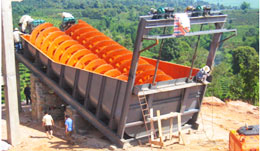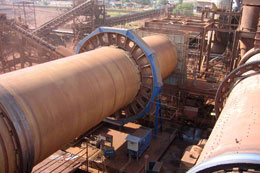-
Sand Making Crusher
- PCL-Vertical Shaft Impact Crusher
- SBM Hydraulic VSI Crusher
- VSI5X Series Impact Crusher
Gold beneficiation equipment
Gold beneficiation plant equipment

Gold beneficiation plant is mainly consisted of Vibrating Feeder,Jaw Crusher,Ball Mill,Classifier, Magnetic Separator, Flotation Machine, Condensing Machine ,Spiral Separator and Drying Machine. With the equipment Feeder, Hoister and Conveyor, a full set of Beneficiation Equipment Production Line can be made. It features as High efficiency, Low Consumption, High Output and economical and reasonable, etc.y
Gold beneficiation processing

Roasting: Where gold is trapped in sulfides such as pyrite, roasting of the concentrate is required to convert the sulfides to oxides (called calcine), with sulfur in the sulfides liberated as sulfur dioxide. Oxidation is necessary for the subsequent gold leaching and recovery processes to operate effectively.
Biological Oxidation: This is an alternative method for the oxidation of sulfides. Recent advances in technology have resulted in the development of a biological process for the oxidation of sulfide concentrates. In this process bacteria are used to oxidise sulfide concentrates.
Cyanidation: Cyanide is added to the process slurry to promote the dissolution and complexing of the gold. Gold enters solution as a gold-cyanide complex ion.
Carbon-in-pulp (CIP): CIP involves the removal of complex gold ions from solution by adsorption onto activated carbon. Slurry that has undergone cyanidation is passed through a cascade of agitation tanks. As the slurry moves down the cascade, gold is adsorbed onto granular activated carbon that is extracted and pumped to the next tank. The result is a counter-current flow (as Figure 3), where the loading of gold on carbon increases in the opposite direction to slurry flow. Loaded carbon is retrieved from the first tank in the series.
Gold Beneficiation Methods
As discussed above, gold beneficiation operations include cyanidation, base-metal flotation, gravity concentration (for placer deposits), and amalgamation (which is generally no longer used). Base-metal flotation, gravity concentration, and amalgamation are described only briefly below. Because most lode ore gold mines use some form of cyanidation, these techniques are the main focus of this profile. In general, there are two basic types of cyanidation operations, tank leaching and heap leaching. In addition, tank leaching involves one of two distinct types of operations, Carbon-in-Pulp or Carbon-in-Leach. In Carbon-in-Pulp operations, the ore pulp is leached in an initial set of tanks with carbon adsorption occurring in a second set of tanks. In Carbon-in-Leach operations, leaching and carbon recovery of the gold values occur simultaneously in the same set of tanks.
- Limestone Crusher
- Barite Crusher
- Granite Crusher
- Kaolinite Crusher
- Calcite Crushing
- Tombarthite Crusher Mill
- Bentonite Grinding Plant
- Basalt Ore Crusher
- Lignite Crusher Mill
- Silica Ore Crusher
- Tin Ore Mine
- Lead and Zinc Ore Crusher
- Ochre Crusher Mill
- Garnet Crusher
- Mica Crusher
- Asbestos Crusher
- Manganese Ore Crusher
- Talc Crusher Mill
- Feldspar Crusher
- Iron Ores Crusher
- Dolomite Crusher
- Quartz Crusher
- Gypsum Crusher
- Calcium Carbonate Grinding
- About Us
- |
- Service
- |
- News & Events
- |
- Contact Us
- |
- Resources
- |
- Showroom
Aggregate Crusher
Artificial Sand Making
Ballast Crushing Machine
Basalt Stone Crusher
Barite Mine Process
Beneficiation Plant
Bentonite Crusher
Bentonite Milling
Calcium Carbonate Crusher
Calcium Carbonate Grinding
Cement Grinding
Concrete Crusher
Coal Crusher
Copper Crusher
Cement Mill
Chrome Mining Process
Copper ore Beneficiation
Coal Processing
Coal Pulvarizer
Feldspar Crushing
Feldspar Grinding
Flotation Machine
Gold Crusher
Gold Mine Equipment
Gold Processing Machinery
Granite Crusher
Granite Crushing Machine
Granite Quarry Equipment
Gypsum Crusher
Gypsum Mining
Gypsum Powder Production
Iron Ore Beneficiation
Iron Ore Crusher
Kaolin Processing Plant
Limestone Crusher
Silica Sand Crusher
Iron Ore Mining Equipment
Cement Production Line
Talc Production Line
Quartz Crushing Machine
Limestone Mining Process
Manganese Benificietion
























